
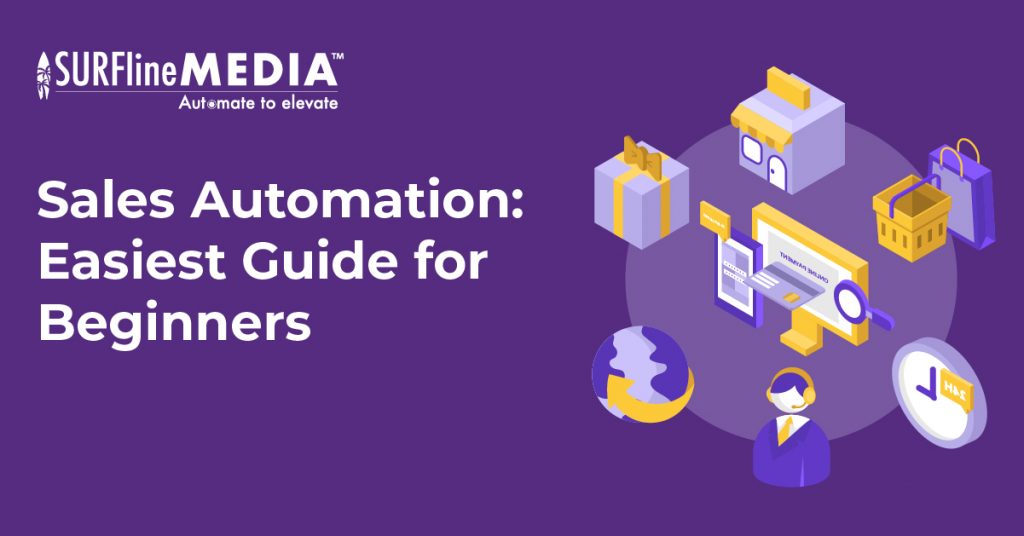
- October 2, 2023
- 4:10 pm
- No Comments
Sales Automation: The Easiest Guide for Beginners
Sales automation is a game-changer in today’s competitive business landscape, offering a multitude of benefits that can significantly boost your sales team’s efficiency and effectiveness. Yet, for beginners, the world of sales automation might seem complex and daunting. In this easy-to-follow guide, we will unravel the intricacies of sales automation, providing you with a comprehensive understanding of what it entails and how it can revolutionize your sales processes. This guide is your gateway to unlocking the potential of sales automation without the overwhelming technical jargon.
1. Sales Automation
Sales automation refers to the use of software and technology tools to automate and streamline various sales processes and tasks within an organization. This includes automating tasks such as lead generation, data entry, customer communication, order processing, and reporting. The primary goal of sales automation is to increase efficiency, productivity, and effectiveness in the sales process while reducing manual and time-consuming efforts.
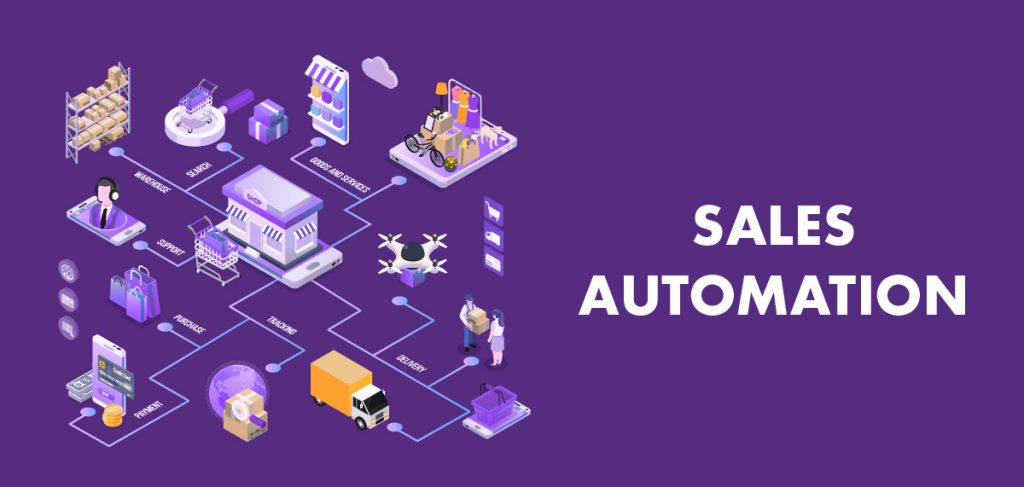
Sales automation refers to the use of software and technology tools to automate and streamline various sales processes and tasks within an organization.
By automating repetitive and routine tasks, sales teams can focus on more strategic activities like building relationships with customers, closing deals, and generating revenue. Sales automation also often involves the integration of customer relationship management (CRM) systems, marketing automation, and analytics tools to provide insights, track performance, and optimize sales strategies.
Overall, sales automation plays a crucial role in modern sales operations, enabling businesses to better manage their sales pipelines, improve customer interactions, and drive growth.
2. Benefits of Sales Automation
2.1. Streamlining Sales Processes for Efficiency
Sales automation systems are designed to streamline and optimize various sales processes within an organization. By automating routine tasks such as data entry, lead assignment, and follow-up reminders, these tools eliminate time-consuming manual work. This not only reduces the risk of errors but also allows sales teams to operate with greater efficiency. With streamlined processes, sales representatives can allocate more of their time and energy to building customer relationships and closing deals. As a result, the entire sales cycle becomes more efficient, leading to quicker conversions and revenue generation.
2.2. Enhanced Lead Management and Tracking
One of the key benefits of sales automation is its ability to handle lead management and tracking with precision. Automation tools can capture leads from various sources, score them based on predefined criteria, and route them to the appropriate sales representatives. Moreover, these tools facilitate lead nurturing by automating personalized email sequences and follow-up tasks. This ensures that leads are engaged and educated throughout their journey, increasing the likelihood of conversion. By offering a centralized platform for lead management, sales automation systems empower sales teams to focus their efforts on leads with the highest potential, resulting in improved conversion rates and higher revenue.
2.3. Improved Customer Relationship Management
Sales automation goes beyond lead management; it also plays a pivotal role in enhancing customer relationship management (CRM). By maintaining a centralized database of customer information, interactions, and transaction history, sales reps can access a comprehensive view of each customer. This enables them to personalize their sales approach, addressing specific customer needs and preferences. Improved CRM fosters stronger customer relationships, leading to higher customer satisfaction and loyalty. When customers feel understood and valued, they are more likely to continue doing business with the company, potentially resulting in repeat sales and referrals.
2.4. Data-Driven Decision Making
Sales automation tools gather and analyze a wealth of valuable sales data. This data-driven approach offers insights into various performance metrics, sales trends, and customer behavior. By leveraging this data, businesses can make informed decisions about their sales strategies. They can identify what’s working and what needs improvement, refine their approach to target the right audience, and optimize resource allocation. This data-driven decision-making process ultimately leads to more effective sales strategies, improved sales team performance, and higher revenue.
2.5. Time and Resource Savings
One of the most tangible benefits of sales automation is the significant time and resource savings it provides. By automating repetitive and time-consuming tasks such as data entry, lead nurturing, and reporting, sales teams can operate more efficiently. This not only boosts productivity but also reduces the risk of errors associated with manual tasks. Sales representatives can focus their efforts on strategic activities, such as building relationships, negotiating deals, and identifying growth opportunities. As a result, organizations can achieve more with their existing resources, leading to increased revenue growth and a stronger bottom line.
3. Key Features and Tools
3.1. Automated Lead Nurturing
This key feature enables businesses to automate the process of nurturing leads by delivering targeted content and resources based on their preferences and behavior. It ensures that leads receive relevant information at the right time, increasing the likelihood of conversion. Automated lead nurturing saves time and resources while maintaining a personalized approach to customer engagement.

Automated Lead Nurturing.
3.2. New Contact Drip Campaigns
Drip campaigns are a series of automated emails designed to guide leads through the sales funnel. Sales automation tools offer the capability to create and manage these campaigns efficiently. It allows businesses to stay in regular contact with prospects, delivering valuable content and information, and ultimately driving them towards making a purchase.

New Contact Drip Campaigns
3.3. Email and Text Message Marketing
Sales automation platforms provide the ability to send and track email and text message marketing campaigns. This feature streamlines communication with leads and customers, ensuring that important messages reach their intended recipients. It also allows for tracking engagement metrics to measure the effectiveness of campaigns.
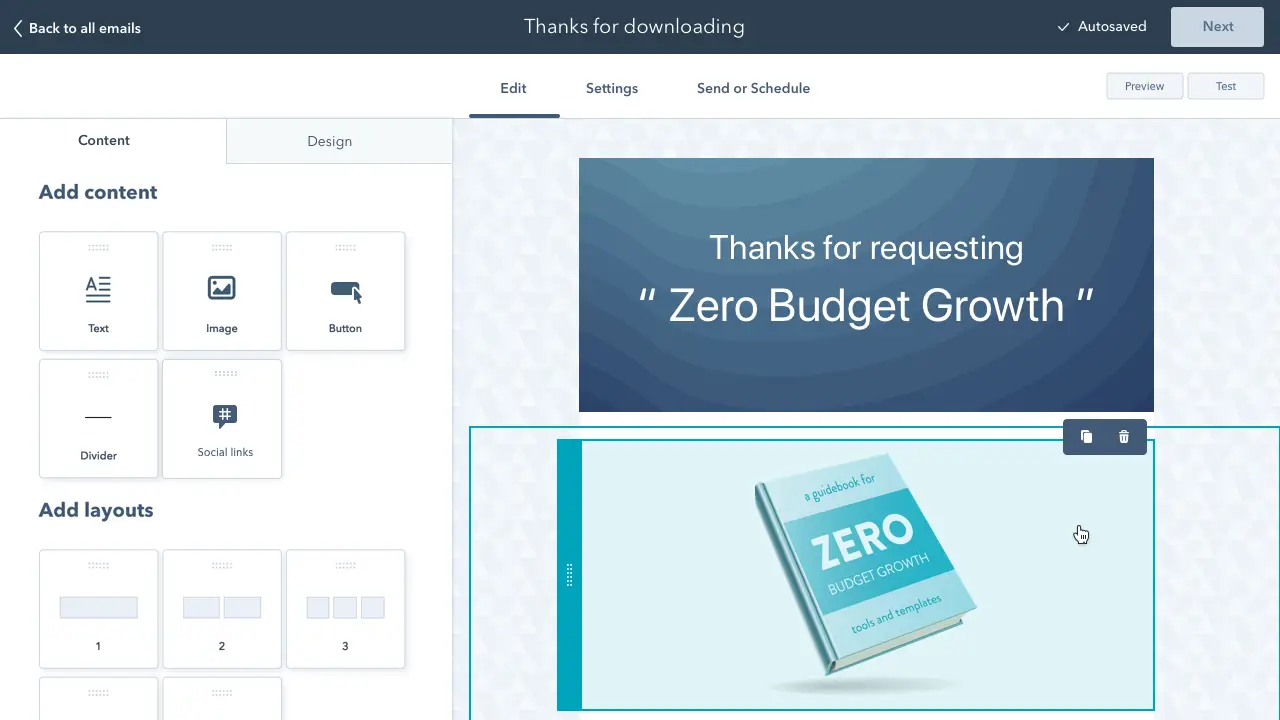
Sales automation platforms provide the ability to send and track email and text message marketing campaigns.
3.4. Landing Page Templates
Creating visually appealing and effective landing pages is crucial for lead generation. Sales automation tools often come with pre-designed templates that make it easy for businesses to create landing pages without the need for design or coding skills. These templates are customizable to align with specific campaign goals.

Landing Page Templates.
3.5. Customizable Forms
Lead capture forms are essential for gathering information about leads. Sales automation software offers customizable form creation, enabling businesses to tailor forms to collect the data that matters most to them. This feature ensures that businesses can segment and target their leads effectively.
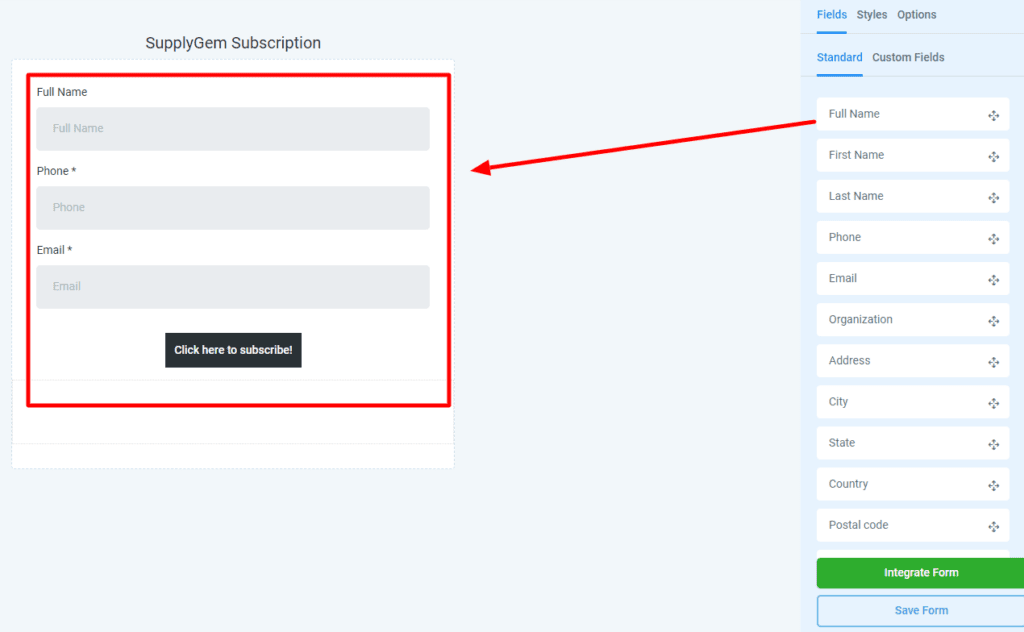
Customizable Forms.
3.6. Social Media Platform Management
Managing multiple social media accounts can be time-consuming. Sales automation tools simplify this process by providing a centralized platform for scheduling and posting content across various social media networks. It allows businesses to maintain a consistent online presence and engage with their audience efficiently.
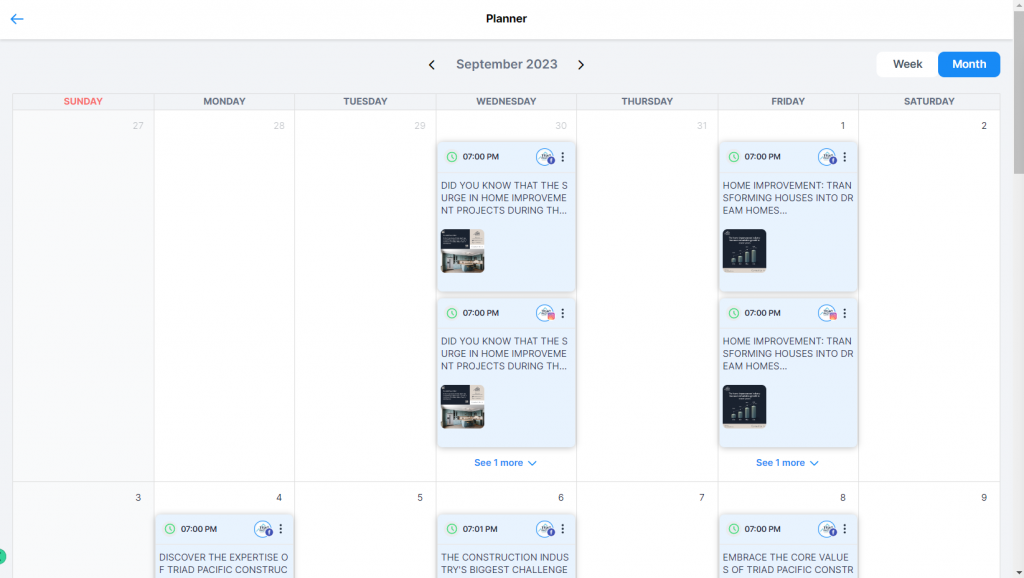
Social Media Platform Management.
3.7. Opportunity and Sales Pipeline Manager
Visualizing the sales pipeline and tracking opportunities is vital for sales teams. Sales automation software offers tools to manage and optimize the entire sales process. It helps in identifying bottlenecks, prioritizing leads, and ensuring that sales opportunities are efficiently managed from initial contact to closure.

Opportunity and Sales Pipeline Manager.
4. Implementing Sales Automation in 7 Steps
4.1. Assessment and Goal Setting
Begin by conducting a thorough assessment of your current sales processes. Identify pain points, bottlenecks, and areas where automation can make a significant impact. Set clear and measurable goals and objectives for the automation process. These goals could include improving lead conversion rates, reducing manual data entry errors, enhancing customer communication, or boosting overall sales team productivity.
4.2. Register with Surfline Media’s CRM System
Choose a reputable CRM system like Surfline Media’s CRM to serve as the foundation for your sales automation efforts. Ensure that the CRM aligns with your specific business needs, offers the necessary features for automation, and can scale as your business grows. Registering with Surfline Media’s CRM system provides you with a reliable platform to centralize customer data, track interactions, and streamline your sales processes.
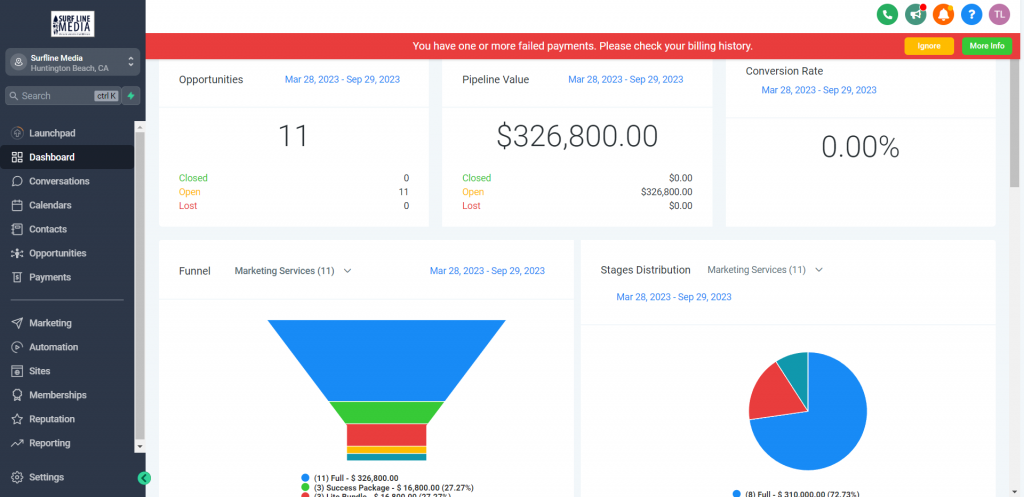
Choose Surfline Media’s CRM for a reliable automation foundation tailored to your business needs.
4.3. Data Migration
Transitioning from manual or disparate systems to an automated one requires a seamless data migration process. It’s essential to ensure that all existing customer data, sales-related information, and historical interactions are accurately migrated to the new system. Data accuracy is critical for effective automation, as any discrepancies or missing information can hinder your sales efforts.
4.4 Customization and Configuration
Tailor the automation software, including the CRM system, to align with your specific sales processes and business requirements. This may involve creating custom fields, defining workflows, setting up automated triggers, and designing templates for emails and documents. The goal is to configure the software to support your unique sales cycle and customer engagement strategies.
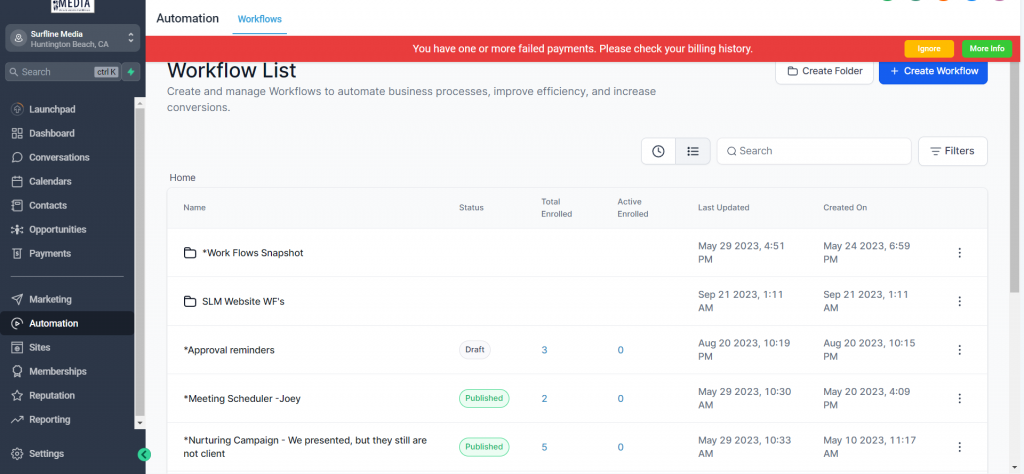
Tailor automation software to match unique sales processes and requirements.
4.5. Training and Onboarding
Provide comprehensive training to your sales team and other relevant staff members to ensure they are proficient in using the new automation tools and processes. Effective training programs should cover how to navigate the CRM system, input and access customer data, initiate automated workflows, and troubleshoot common issues. Offer ongoing support and resources to address questions and concerns as they arise during the onboarding process.
4.6. Integration with CRM
For seamless automation, it’s crucial to integrate your chosen sales automation system with your Customer Relationship Management (CRM) software. Integration ensures that customer data is synchronized between the two systems, providing a unified view of customer interactions and sales activities. This integration enhances communication and collaboration among your sales team members, enabling them to work more efficiently.
4.7. Workflow Automation
Identify and automate routine and repetitive tasks within your sales processes. This includes tasks such as lead assignment, follow-up emails, appointment scheduling, and data entry. Automating these processes not only saves time but also reduces the risk of errors. It allows your sales team to redirect their efforts toward high-value activities like building relationships with prospects and closing deals. As workflows become automated, you’ll experience increased efficiency and productivity throughout your sales organization.
5. Real-Life Success Stories
5.1. Case 1: Amazon
Amazon, the e-commerce giant, attributes much of its success to CRM analytics. By analyzing customer data from various touchpoints, they personalize recommendations and marketing strategies. This approach increased their sales by 29% in 2019. Amazon’s CRM analytics also played a crucial role in improving customer service. They used sentiment analysis to identify dissatisfied customers and proactively resolve their issues, resulting in a 50% decrease in customer complaints. Amazon’s commitment to CRM analytics continues to drive its customer-centric approach and maintain its status as a global e-commerce leader.

Amazon, the e-commerce giant, attributes much of its success to CRM analytics (source: Internet).
5.2. Case 2: American Airlines
American Airlines transformed its customer relationships using CRM analytics. Facing increased competition, they leveraged data to enhance the passenger experience. By analyzing travel patterns and preferences, they optimized flight schedules and pricing strategies, resulting in a 10% revenue increase. Additionally, American Airlines utilized predictive analytics to identify potential flight disruptions, enabling them to proactively rebook passengers and reduce delays by 15%. This customer-centric approach not only improved customer satisfaction but also strengthened their competitive edge in the airline industry.

American Airlines transformed its customer relationships using CRM analytics (source: Internet).
6. Where to find the Best Sales Automation?
For the best sales automation solution, choose Surfline Media. We offer a high-quality CRM system that seamlessly integrates all essential functions specialised for small businesses. What sets us apart is our user-friendly interface, making it easy for your team to adapt and maximize productivity. Our CRM system empowers businesses to streamline their sales processes, from lead generation to closing deals, while also providing valuable analytics for informed decision-making.
As an added bonus, we currently offer a one-month free trial for business owners, allowing you to experience the benefits of our CRM system firsthand without any financial commitment. Don’t miss this opportunity to supercharge your sales efforts with Surfline Media’s cutting-edge automation tools.
_______________________

Surfline Media – Automate to Elevate
Our website: https://surflinemedia.com/
Contact us: https://surflinemedia.com/contact-us/
Phone number: 877.358.9909
Email: [email protected]






